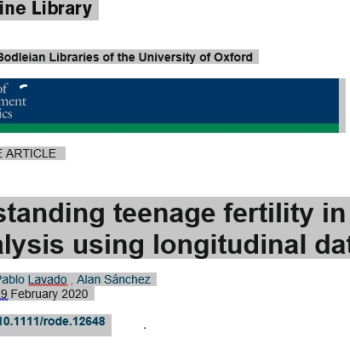Publication Information

Reducing the prevalence of teenage pregnancy remains an elusive goal for public policy in Peru. In this article, just published in the Review of Development Economics, the authors use longitudinal data from the Young Lives Study in Peru to investigate which early circumstances and life changes might be the risk factors for teenage childbearing—about one out of five girls in the sample was a teenage mother.
Their results show that growing up in a poor household, being raised in a single-parent household, leaving school at or before age 15, performing badly in school at age 12, and having a first sexual relationship at or under age 16 are all key risk factors for early childbearing.
From a time-varying perspective, the authors uncover the importance of changes in the characteristics of a child and household that occurred prior to childbearing. Among other factors, they find that improvements in self-efficacy and education aspirations during adolescence are associated with a decrease in the probability of early childbearing. Risk factors identified are considerably more relevant—in most cases, only relevant—for girls.
From a policy perspective, the results presented suggest that initiatives aimed at improving school attendance, sexual education, and socioemotional competencies among adolescents might be effective tools to reduce the high rates of teenage pregnancy in Peru
You can view and download a copy of the article here.

Reducing the prevalence of teenage pregnancy remains an elusive goal for public policy in Peru. In this article, just published in the Review of Development Economics, the authors use longitudinal data from the Young Lives Study in Peru to investigate which early circumstances and life changes might be the risk factors for teenage childbearing—about one out of five girls in the sample was a teenage mother.
Their results show that growing up in a poor household, being raised in a single-parent household, leaving school at or before age 15, performing badly in school at age 12, and having a first sexual relationship at or under age 16 are all key risk factors for early childbearing.
From a time-varying perspective, the authors uncover the importance of changes in the characteristics of a child and household that occurred prior to childbearing. Among other factors, they find that improvements in self-efficacy and education aspirations during adolescence are associated with a decrease in the probability of early childbearing. Risk factors identified are considerably more relevant—in most cases, only relevant—for girls.
From a policy perspective, the results presented suggest that initiatives aimed at improving school attendance, sexual education, and socioemotional competencies among adolescents might be effective tools to reduce the high rates of teenage pregnancy in Peru
You can view and download a copy of the article here.

